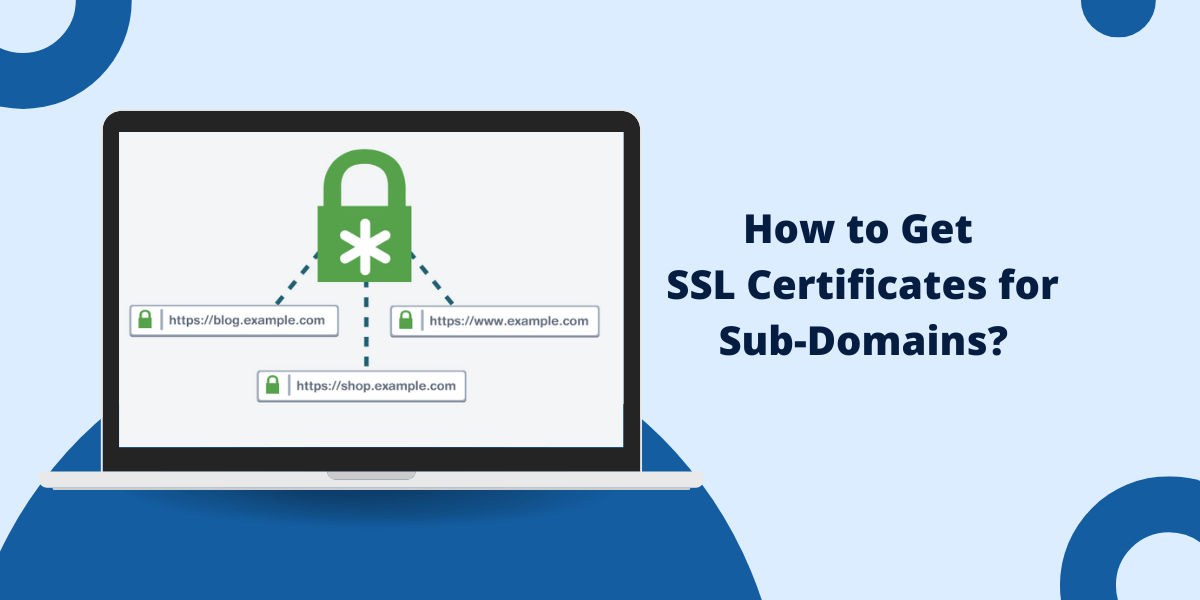What Are SSL Certificates for Subdomains and How to Use Them
Securing your website with SSL (Secure Sockets Layer) certificates is essential for protecting sensitive user data and maintaining the trust of your visitors. When it comes to how to get SSL certificates for sub-domains, the process can be slightly more complex than securing the main domain.
You need to properly configure and install SSL certificates for each sub-domain. In this guide, we’ll walk you through the steps to obtain and configure SSL certificates for your sub-domains, ensuring end-to-end encryption and a secure browsing experience for your users across all areas of your web presence.
We’ll cover topics such as choosing the right SSL provider, generating, and installing the certificates, and troubleshooting any common issues that may arise during the process.
Key Takeaways
- Subdomains need separate SSL certificates from the main domain. A wildcard certificate covers the main domain and subdomains.
- The process involves generating a Certificate Signing Request (CSR) for each subdomain and submitting it to the certificate authority.
- SSL certificates utilize domain validation, so you must prove control of each subdomain.
- Certain certificate types, like EV SSL, are not available for subdomains. Opt for domain-validated certificates.
- Install the issued certificates on your server and configure HTTPS encryption for each subdomain.
- Renew the SSL certificates before expiration to maintain security. Automate renewals for convenience.
What are Subdomains and How are They Secured?
A subdomain is an additional domain that is part of your main website domain. For example, if your website is example.com, subdomains would be:
- mail.example.com
- login.example.com
- support.example.com,
- checkout.example.com, etc.
Subdomains act as separate hosts with their domain names. To secure subdomains with SSL, you cannot use the certificate issued for the main domain. Each subdomain needs its own unique SSL certificate for full encryption.
The only exception is a Wildcard SSL certificate. This certificate type secures the main domain and an unlimited number of subdomains. However, wildcard certificates cost more than individual subdomain certificates.
SSL (Secure Sockets Layer) certificates enable the Tune icon in the browser. This encrypts communication between the website and users to prevent cyberattacks. Customers will only submit sensitive data through HTTPS sites as they distrust HTTP.
Prerequisites for Getting Subdomain SSL Certificates
Before applying for SSL certificates for subdomains, ensure you meet the prerequisites:
Control over Subdomains
You must have full control over the subdomains to get SSL certificates issued for them. Your domain registrar should provide you with the ability to manage DNS records for subdomains. This allows the creation of new subdomains and the assigning of IP addresses to them.
Registered Domain Name
Your main domain name must be registered and active. Subdomains stem from the parent domain, so they must be valid.
Live Subdomains
The subdomains you are securing should already be created and active. They should point to valid IP addresses and load actual site content.
Web Hosting Platform
You need an active web hosting account that gives you server access. This allows you to install SSL certificates and configure HTTPS for subdomains.
9 Easy Steps to Get SSL Certificates for Subdomains
Follow this step-by-step guide to issue and set up SSL certificates correctly on subdomains.
- Choose a Certificate Authority
- Verify You Have Domain Control
- Generate a Certificate Signing Request
- Purchase the Subdomain Certificates
- Download and Install the SSL Certificates
- Force HTTPS with Redirects
- Test and Confirm SSL Activation
- Add HSTS Header for Added Security
- Set Auto-Renewals on the Certificates
1. Choose a Certificate Authority
Certificate authorities (CAs) are entities that issue SSL certificates. Some options are:
- Sectigo: Affordable prices and wide browser compatibility.
- RapidSSL: Budget SSL plans with fast issuance.
- GeoTrust: Reliable CA with strong encryption support.
- DigiCert: Reputable vendor with server licensing bundles.
2. Verify You Have Domain Control
Certificate authorities need proof you own the subdomains you are securing. Log in to your domain registrar account and check you have access to manage DNS settings.
Create a TXT record for each subdomain to verify domain ownership. The CA will provide the exact TXT values to add. This step confirms you have the right to obtain certificates.
3. Generate a Certificate Signing Request
A CSR (Certificate Signing Request) is an encoded file used to apply for SSL certificates. It contains your details and public key for encryption.
Use the CSR generation tool on your server or the OpenSSL commands. You need a separate CSR for each subdomain to submit.
When creating the CSRs, make sure to specify the correct subdomain in the Common Name (CN) field. This subdomain should match the domain names you intend to secure.
4. Purchase the Subdomain Certificates
For subdomains, choose certificate types like DV SSL (Domain Validated) or OV SSL (Organization Validated) SSL. EV SSL (Extended Validation) certificates require more proof and are often not issued for subdomains.
Once you complete the certificate order and pay, the CA will instantly issue the certificates if you have already verified domain control.
5. Download and Install the SSL Certificates
Access your CA account to download the SSL certificates you purchased for each subdomain. You will receive certificate files such as domain.crt and domain.key.
Use the control panel to upload and install these certificate files on your web server. Then, add the certificates to the associated subdomain websites.
6. Force HTTPS with Redirects
Sites load over HTTP instead of HTTPS by default. To enforce encryption, set up permanent redirects (301) to the HTTPS version of each subdomain.
The redirect rules should send all HTTP traffic to HTTPS. This provides secure access and avoids mixed content errors.
7. Test and Confirm SSL Activation
Test by visiting each subdomain in your browser. The URL display a Tune icon before the URL.
Click the Tune icon and confirm that the certificate details match the subdomain and have a trusted root certificate authority. If you see these indicators, the SSL is correctly activated.
8. Add HSTS Header for Added Security
HTTP Strict Transport Security (HSTS) instructs browsers to only interact with the subdomain over HTTPS for a defined period. This prevents man-in-the-middle attacks.
Have your web admin add a Strict-Transport-Security header on each subdomain to enforce HSTS. This header completely restricts HTTP access, ensuring optimal security.
9. Set Auto-Renewals on the Certificates
SSL certificates have an expiration date, typically valid for one year. They must be renewed annually to maintain active HTTPS and security.
Enable auto-renewal on the certificates so you remember. The CA will automatically renew them before expiry. Alternately, you can manually renew the certificates every year.
Following these steps will get you the SSL certificates needed to encrypt subdomains fully. Take care to renew them annually.
Final Thoughts
In conclusion, securing sub-domains with how to get SSL certificates for sub-domains is a crucial step in maintaining a comprehensive and secure web presence. By following the steps outlined in this guide, you can efficiently obtain and configure SSL certificates for your sub-domains, ensuring that all areas of your website are protected from potential security threats.
From choosing the right SSL provider to properly installing and managing the certificates, this process may require some initial effort, but the benefits of providing a secure browsing experience for your users far outweigh the investment.
With SSL certificates in place, you can confidently grow and expand your website, knowing that your sub-domains are safeguarded against data breaches and other cyber-attacks.
Frequently Asked Questions about Subdomain SSL Certificates
Here are answers to some frequently asked questions about securing subdomains with dedicated SSL certificates:
Do subdomains need separate SSL certificates?
Yes, because each subdomain is recognized as an individual domain, it requires a unique SSL certificate. The only exception is a wildcard SSL certificate that supports unlimited subdomains.
Can I use a free SSL certificate for subdomains?
Most CAs do not issue free SSL certificates for subdomains. However, you can use free services like Let’s Encrypt if you have the technical expertise to install and configure the certificates.
Is a multidomain or UCC certificate better than an individual cert?
A multidomain certificate can secure up to 100 domains. However, subdomains on the same root domain count as individual domains. So, multidomain certs do not specifically benefit subdomains.
Do the subdomains need to be on separate IPs?
No, subdomains don’t require dedicated IPs. They can point to the same IP as the main domain. The only requirement is that they are configured as active domains.
Can I get an EV certificate for a subdomain?
Typically, not. EV validation requires proving the legal existence of the domain owner. This is only possible for main domains registered as companies. Subdomains don’t have separate business registrations.
What is the average cost per subdomain certificate?
DV SSL certificates cost $4 to $15 per subdomain annually. OV SSL and EV SSL certificates are much more expensive at $150+ per subdomain per year.
Can I use subdomain certificates on different servers?
Yes, you can install the same subdomain certificate on multiple servers like a web farm. The certificate isn’t tied to a specific server.
Do subdomain certificates renew automatically?
No, subdomain SSL certificates must be manually renewed before expiration. Auto-renewal is usually only available on wildcard certificates covering all subdomains.

Priya Mervana
 Verified Web Security Experts
Verified Web Security Experts
Priya Mervana is working at SSLInsights.com as a web security expert with over 10 years of experience writing about encryption, SSL certificates, and online privacy. She aims to make complex security topics easily understandable for everyday internet users.

![What is Certificate Revocation List [CRL]?](https://sslinsights.com/wp-content/uploads/2024/01/certificate-revocation-list-crl.png)
